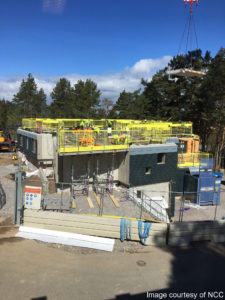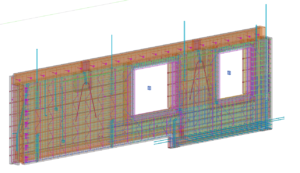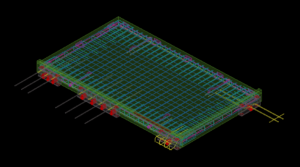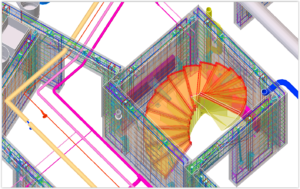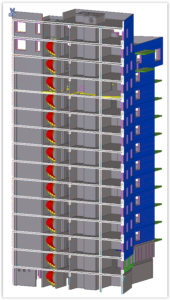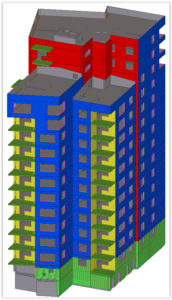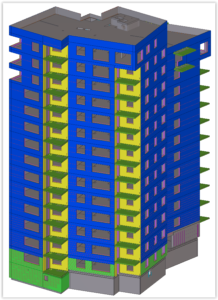Höjdpunkten

| Category | Commercial Projects |
|---|---|
| Year | 2017 |
| Country | Poland |
| Organization | CONSTRAVIA Sp. z o.o. |
| Author | Byggritningar |
| Co-authors | Höjdpunkten |
| Client | NCC |
| Place of construction | Linköping, Sweden |
| Tags |
Höjdpunkten in Swedish means peak. The 43m tall building will be one of the highest structures in Linköping, the 5th biggest city in Sweden. Non-typical architecture demanded non-typical solutions from structural engineers. Due to that combination future apartments’ owners will have breath-taking views from wide windows and balconies.
Building was designed in line with precast concrete technology and prepared as design-and-build. This allowed to keep high standard of elements even despite its complicated geometry. For the needs of described structure two types of precast elements were used – sandwich walls as external and massive walls as internal. Using BIM technology helped to avoid collisions between all branches involved. All problems was solved in 3D model, before process moved to factory or on site. Thanks to possibilities of Tekla Structures we made documentation very fast and avoid mistakes.
Introducing complicated shape of the building was one of the most challenging process. Walls are rarely perpendicular to each other, which demands high precision from team responsible for model. Local coordinate system is introduced to match building geometry accordingly to architectural layout. Connection between precast elements has to have both structural and insulation meaning. Due to that fact we decided to introduce on guidelines for installation insulation layers on drawings. Höjdpunkten was the first project where surface treatment were used by our company. Outer panels colour were introduced, and then simultaneously appeared on drawings. During filigree slabs design Tekla’s built-in component (braced girder) was used. As total filigree area is more than 4500 m2, we were in need of fast and trustworthy tool, as that one was. Drawings of slabs were plot in format Unitechnik 6.0. As a consequence work in factory was nearly fully-automatic process, whilst hard copies were used just for additional control. All of parts attached to assembly were modelled in fixed way, and that allowed to create dimensioning rules. We are proud to say, that highly precise, detailed drawings were drawn nearly by themselves. That, of course, minimize risk of any errors, accelerate work and make it more enjoyable. All tools we used during modelling had profound impact on teamwork both inside our company and with structure’s executor on-site.
Höjdpuntken is under construction and first few floors are done by now. The estimated completion is scheduled for autumn 2018.
Höjdpunkten in Swedish means peak. The 43m tall building will be one of the highest structures in Linköping, the 5th biggest city in Sweden. Non-typical architecture demanded non-typical solutions from structural engineers. Due to that combination future apartments’ owners will have breath-taking views from wide windows and balconies.
Building was designed in line with precast concrete technology and prepared as design-and-build. This allowed to keep high standard of elements even despite its complicated geometry. For the needs of described structure two types of precast elements were used – sandwich walls as external and massive walls as internal. Using BIM technology helped to avoid collisions between all branches involved. All problems was solved in 3D model, before process moved to factory or on site. Thanks to possibilities of Tekla Structures we made documentation very fast and avoid mistakes.
Introducing complicated shape of the building was one of the most challenging process. Walls are rarely perpendicular to each other, which demands high precision from team responsible for model. Local coordinate system is introduced to match building geometry accordingly to architectural layout. Connection between precast elements has to have both structural and insulation meaning. Due to that fact we decided to introduce on guidelines for installation insulation layers on drawings. Höjdpunkten was the first project where surface treatment were used by our company. Outer panels colour were introduced, and then simultaneously appeared on drawings. During filigree slabs design Tekla’s built-in component (braced girder) was used. As total filigree area is more than 4500 m2, we were in need of fast and trustworthy tool, as that one was. Drawings of slabs were plot in format Unitechnik 6.0. As a consequence work in factory was nearly fully-automatic process, whilst hard copies were used just for additional control. All of parts attached to assembly were modelled in fixed way, and that allowed to create dimensioning rules. We are proud to say, that highly precise, detailed drawings were drawn nearly by themselves. That, of course, minimize risk of any errors, accelerate work and make it more enjoyable. All tools we used during modelling had profound impact on teamwork both inside our company and with structure’s executor on-site.
Höjdpuntken is under construction and first few floors are done by now. The estimated completion is scheduled for autumn 2018.


